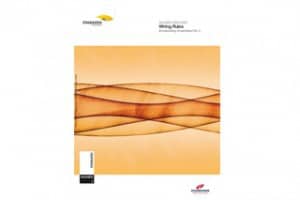Changes to the Wiring Rules and HVAC installation requirements
Australian/New Zealand Standard (AS/NZS) 3000:2007, or the Wiring Rules as it’s more commonly known, provides rules and guidelines for all types of electrical equipment and installations. Electrical contractors are required to comply with these guidelines for all electrical works conducted in domestic and commercial installations.
Recently, AS/NZS3000 was amended to expand on issues relating to electrical installations, improving safeguards and including new clauses surrounding the use of gas appliances and air conditioners.
ADVERTISEMENT
Known as Amendment 2, it was released in December 2012 and is the first update since July 2009.
In the new Amendment, Clause 4.19 specifically relates to air conditioning and heat pump systems. It states:
“Air conditioning and heat pump systems incorporating a compressor shall be provided with a lockable isolating switch installed adjacent to the unit, which isolates all parts of the system including ancillary equipment, from the same location.
“For split system air conditioning units, where the manufacturer requires the air conditioning system to be connected to the electricity supply by means of a plug and socket at the internal unit, the isolating switch installed at the external unit shall control the socket-outlet located at the internal unit.
“Exception: the isolating switch may be installed at the switchboard supplying the system if the switchboard is dedicated to the equipment (e.g. an air conditioning plant room).”
This Clause has been written to clear up any misconceptions regarding the use of an isolator for the installation of air conditioners in residential or commercial projects.
For those air conditioners that still use a 3-pin plug and socket on the indoor unit for the power supply, an isolator must be installed adjacent to the outdoor unit containing the compressor. This Clause now clarifies the use of an isolator on all installed air conditioners regardless of the power connection on the product itself.
Although the majority of contractors will already be installing isolators according to the new guidelines, the Amendment makes it better, easier and safer for the service industry, ensuring there is a quick point of isolation for servicing and maintenance of the air conditioner.
This also reduces the damage that can be caused by isolator installation on the unit. This damage greatly inhibits manufacturers as, based on experience, it is quite common to have PCBs or even refrigerant pipes in the outdoor unit damaged by the installation of these isolators on the outdoor unit.
How did this amendment come about?
Movements of State-based electrical authorities may have influenced this revision.
In 2011, Energy Safe Victoria (ESV) issued a directive to allow for the safe maintenance of fixed wired air conditioning units. Since then, it has been a requirement of Victorian installations that fixed wired air conditioning units are installed to comply with the following requirements:
1. They must have an isolating switch that is capable of being locked in the ‘off’ position, installed adjacent to or on the external compressor unit (an exception to this requirement is where an isolating switch that is capable of being locked in the ‘off’ position may be installed in a switchboard that is dedicated to the air conditioning equipment only); and
2. Be installed as per the manufacturer’s installation instructions as required by Clause 1.7.1(c) of the 2007 Wiring Rules; and
3. Only cables enclosed in conduits are to be attached to the air conditioning pipe work (note that the means of attachment must be permanently secured – use of PVC tape or plastic cable ties is not acceptable).
These directives are a requirement in Victoria and it is understood other regions are investigating similar requirements.
It is believed that these directives have led to the addition of Clause 4.19 in recent amendment to the Wiring Rules.
The new Amendment presents an opportunity for contractors to accommodate the additional time required for correct installation within job quotations.
As previously mentioned, the Wiring Rules is the industry bible and therefore what is stated in the guidelines regarding installation is how all jobs should be approached and completed.
It is a requirement under Clause 1.7.1 of the AS/NZS 3000:2007 Wiring Rules that all electrical wiring installations must comply with the manufacturer’s instructions. If an installation does not meet the manufacturer’s instructions, then responsibility will lie with the contractor.
In conclusion, every air conditioner is different and all manufacturers have different requirements for the installation of their products.
Contractors should check with the manufacturer or review the installation manual before installing any air conditioning units to ensure the system has an adequate power supply to operate at its optimum efficiency.
-
ADVERTISEMENT
-
ADVERTISEMENT


